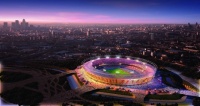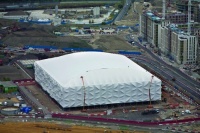
The once magnificent Olympic Park in Athens has become a ghost town. Even the most enthusiastic tourists struggle to find remnants of former sporting glory among abandoned Olympic buildings that are now covered in litter and graffiti.
Once described as the ’dream games’ by the International Olympic Committee (IOC), the empty stadia for the 2004 games have become national symbols of excessive spending and lavish design. As Greece grapples with more than $300bn (£230bn) of public debt, London is hoping to learn from past mistakes by staging what it hopes to be the world’s first ’sustainable games’.
For many, spending £9.4bn for two weeks of sport is irresponsible and extravagant, especially at a time when the country is trying to claw its way out of recession. But the Olympic Development Authority (ODA) claims that, this time, taxpayers’ money will be put to good use to provide long-term benefits for the country, with engineers and architects set to play a crucial part in its success.
It plans on using temporary and reusable structures, where possible, to regenerate a particularly rundown area of East London and change attitudes towards sustainability throughout the country. ’Games mode’ and ’legacy mode’ have become common phrases in the language of the ODA. It is obvious that they have gone to great lengths to think about sustainability, judging by the impressive amount of literature on the topic. But how far do the current designs really reflect the ODA’s ambitions to provide a lasting legacy for London?
“There are contrasting demands for making something for games and something for legacy”
BILL GROSE, ARUP
In a recent report from the Commission for Sustainable London 2012, chair Shaun McCarthy said that he was ’concerned that the ambition to use the games to inspire more sustainable behaviour will not be fully realised’. He claimed sweeping statements that the Olympic Park is set to become a ’blueprint for sustainable living’ have not yet been backed up by comprehensive plans. The ODA, however, maintains that, following the games, the infrastructure will become a central part of the East London community and serve as an inspiration to other host cities.

Owned by Barr Construction, the 12,000-seat basketball arena will be wrapped in 20,000m2 of recyclable white PVC membrane that has been stretched over three different types of arched panel. It will be purpose built, with all doors at least 2.4m high to accommodate the size of the athletes. During the games, the exterior will act as a canvas for an artistic and lighting design. ’Materials for the main structure have been chosen to be taken apart easily,’ explained project sponsor Richard Arnold. ’These include steel for the structure and PVC for the cladding. We have also used scaffolding for the seating structure and are using highly recycled gypsum boards to form the toilets beneath the seating.’
Meanwhile, smaller temporary structures are being built throughout the Olympic Park, including a 250m-long bridge that will be used as one of the main points of pedestrian access into the games. The canals and waterways of the River Lea are being cleaned and widened, and it is hoped that part of the natural floodplains of the area will be restored to provide a new wetland habitat. After the games, the Olympic Village that had been home to the athletes will be converted into homes for key workers. The plan is for the new homes to be surrounded by 10 hectares of new parklands, open space and recreation areas. Grose believes that these initiatives will lay to rest concerns that designing for both the games and its legacy is not possible.
Raise the roof
The London stadium’s canopy took four weeks alone to lift into position
One of the most challenging aspects in building the Olympic stadium was the construction of the cable-net-supported roof. Made up of 2,500 tonnes of steel tubing, the roof is composed of materials recycled from old gas pipelines and stretches 28m the whole way around the stadium, providing cover for two thirds of spectators. It is formed between the outer white steel roof truss and an inner tension ring more than 30m above the field of play. More than 900 tonnes of scaffolding and more than 1km of support platforms were used to assemble more than 12,000m of cables and walkways. It took four weeks and 46 hydraulic jacks to lift it into position.
’The story so far is one of success in planning and designing this new community in which these games are going to be held,’ he said. ’It’s going to be fabulous and we know that records are going to be broken. I predict that not only are we going to end up with a large number of medals, but when the games have gone the park is designed to regenerate the social and built infrastructure of Stratford.’ East London is one of the poorest areas in the country and has 13 out of the 15 most deprived wards in London. There are high hopes for the area and it could be argued that, without the games, regeneration may have been cheaper, but it may also never have taken place.
After 2012 the ODA is expected to spend around nine months reconfiguring the Olympic park and removing temporary structures before the OPLC takes over. It remains to be seen whether London will zbecome another Athens, or if it will live up to the country’s hopes for regenerating the landscape. The ODA’s intentions are well-placed, but combining Olympic glamour and sustainability may prove to be far more difficult than first anticipated.
Back story - sporting spirit
Despite a minimal budget and a severe lack of food, the 1948 games inspired a sense of community
This isn’t the first time that London has hosted the games in an age of financial turmoil. The 1948 ’Austerity Olympics’ were the first games to take place following the Second World War. The country had no money for new stadiums, housing for athletes or labour for building work. Despite this, the games went ahead and a make-do-and-mend attitude prevailed.
The main athletics circuit at Wembley stadium was a hastily converted dog track with 800 tons of cinders from the hearths of Leicester laid down to form the track. The Empire Pool next door was an ice rink converted into a swimming hall and then, within a few days, into a boxing arena. Athletes were housed in hostels, schools, army barracks and with families who volunteered to provide shelter. One of the biggest logistical problems was food. The British team was training on basic rations of 2,600 calories a day, which increased to 3,300 after selection. Despite barely having enough for themselves, the food shortage inspired a spirit of co-operation among athletes who shared their resources with fellow competitors.
The games were widely considered to be momentous and the government had correctly calculated that they would bring financial benefit to the country. The event cost £732,268 (£20m in today’s money) and made a profit of £29,420, on which £9,000 of tax was paid - a figure that today’s Olympic budgets would do well to learn from.




April 1886: the Brunkebergs tunnel
First ever example of a ground source heat pump?